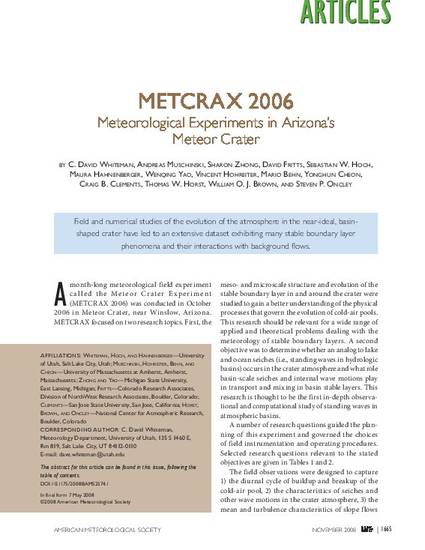
Article
METCRAX 2006 - Meteorological experiments in Arizona's Meteor Crater
Bulletin of the American Meteorological Society
(2008)
Abstract
The Meteor Crater Experiment (METCRAX 2006) was conducted in October 2006 at Arizona's Meteor Crater to investigate stable boundary layer evolution in a topographically uncomplicated basin surrounded by the nearly homogeneous plain of the Colorado Plateau. The two goals of the experiment were 1) to investigate the microscale and mesoscale structure and evolution of the stable boundary layer in the crater and its surroundings and 2) to determine whether atmospheric seiches or standing waves are produced inside the crater. This article provides an overview of the scientific goals of the experiment; summarizes the research measurements, the crater topography, and the synoptic meteorology of the study period; and presents initial analysis results. Analyses show that nighttime temperature inversions form frequently in the crater and that they are often perturbed by internal wave motions. Nighttime cooling produces a shallow (15–30 m deep) surface-based inversion that is surmounted by a horizontally homogeneous near-isothermal layer that extends all the way to the rim, where a second inversion extends above rim level. Seiches are sometimes present on the crater floor. The diurnal propagation of shadows from the crater rim produces important spatial differences in the surface radiation budget and thus the timing of the slope flow transition, and the crater atmosphere is often perturbed during nighttime by a southwesterly mesoscale drainage flow.
Keywords
- Meteorological experiments,
- Arizona's Meteor Crater
Disciplines
Publication Date
2008
DOI
10.1175/2008BAMS2574.1
Publisher Statement
© Copyright 2010 American Meteorological Society (AMS). Permission to use figures, tables, and brief excerpts from this work in scientific and educational works is hereby granted provided that the source is acknowledged. Any use of material in this work that is determined to be “fair use” under Section 107 of the U.S. Copyright Act September 2010 Page 2 or that satisfies the conditions specified in Section 108 of the U.S. Copyright Act (17 USC §108, as revised by P.L. 94-553) does not require the AMS’s permission. Republication, systematic reproduction, posting in electronic form, such as on a web site or in a searchable database, or other uses of this material, except as exempted by the above statement, requires written permission or a license from the AMS. Additional details are provided in the AMS Copyright Policy, available on the AMS Web site located at (https://www.ametsoc.org/) or from the AMS at 617-227-2425 or copyrights@ametsoc.org.
This article was published in the Bulletin of the American Meteorological Society, volume 89, 2008, and can be found online at the following link: http://dx.doi.org/10.1175/2008BAMS2574.1
SJSU users: use the following link to login and access the article via SJSU databases
Citation Information
C. David Whiteman, Sebastian W. Hoch, Maura Hahnenberger, Andreas Muschinski, et al.. "METCRAX 2006 - Meteorological experiments in Arizona's Meteor Crater" Bulletin of the American Meteorological Society Vol. 89 (2008) p. 1665 - 1680 ISSN: 1520-0477 Available at: http://works.bepress.com/craig_clements/15/
